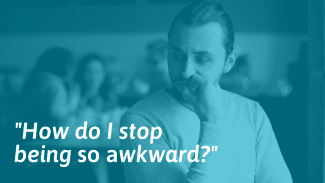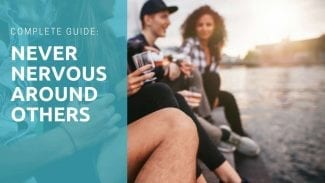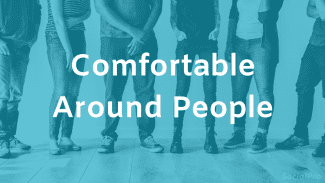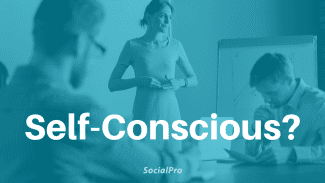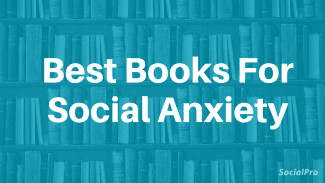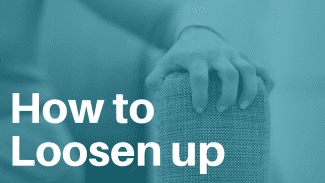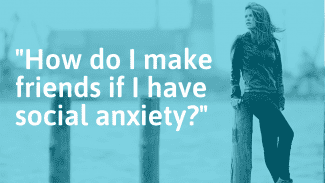If you’re nervous, worried, or dreading the “return to normal” as society re-opens, you’re not alone. Since the start of the pandemic, lockdowns and social distancing policies forced people to adopt new routines that involved a lot more time at home and a lot less social interaction. While you might have found this isolating and difficult at first, you might have become used to this “new normal.” Now, the thought of facing society, seeing people in person, or just leaving home might trigger a lot of anxiety.
This article will provide more information about why so many are experiencing social anxiety and how people can cope and overcome their fears to make the adjustment.
Sections
- 5 reasons why post-pandemic social anxiety is normal
- 10 steps to overcome anxiety and adapt to post-pandemic life
- Coping with social anxiety
5 reasons why post-pandemic social anxiety is normal
In the early days of the pandemic, many struggled with FOMO (or the fear of missing out), longing for time with friends, shopping trips to the mall, and “normalcy.” Nearly two years in, FOMO may have been replaced with FONO (or fear of normal) as many are afraid to resume their old routines.[1][2] According to many experts, these feelings and fears are a normal part of the “re-entry” back to normal life and are something most people are experiencing.[3][4]
1. We’ve become used to virtual interactions
Many people are nervous about in-person social interactions and have become used to interacting with people virtually. Unlike the “virtual reality” where people connect via social media, texts, emails, or video calls, the “real world” feels messy, chaotic, and even scary. Needing to adjust to seeing people in person means giving up many of the controls that virtual communication provides.
Some of the challenges that can cause anxiety about in-person (versus virtual) social interactions are:
- Having unplanned encounters instead of scheduled Zoom calls or meetings and having less time to plan and prepare for conversations.
- Needing to come up with quick responses in conversations instead of being able to think through them and respond in text or email.
- Not having the ability to control the interaction with buttons that allow them to silence, mute, adjust the volume, or hide their camera view during a conversation.
2. Stress and isolation can worsen existing anxiety
Many people with an existing diagnosis found that their social anxiety got worse during the pandemic. Because avoiding social interactions and activities makes social anxiety worse, the social withdrawal and isolation during the pandemic may have been especially bad for people with this disorder.[5] People with existing social anxiety might have the hardest time dealing with FONO and adapting to post-pandemic life.
3. Fears of contracting COVID are still valid
With the ongoing threat of variants, rising case numbers, and waning immunity, there continue to be valid concerns about COVID. People who are concerned about getting sick may be especially likely to feel anxious in indoor settings, crowds, or large gatherings with people.
Many people have even developed a phobia of germs or illnesses during the pandemic, which makes sense given the many strong and urgent health warnings issued worldwide. While these can show up as social anxiety, they may actually be caused by underlying concerns about contracting COVID.[3]
4. Prolonged isolation can diminish social skills
Some people have had very limited interactions during the pandemic and may be feeling like their social skills have diminished a lot. A lot of people feel like they don’t remember how to start a conversation or make small talk with people, simply because it’s been so long since they have.
Like all skills, social skills can get rusty when they aren’t being used and practiced, so it makes sense that after being isolated for so long, people are feeling unprepared to socialize again.
5. Rising stress levels can trigger mental illness
Recent data suggests that the pandemic has caused a major rise in stress and mental health problems in most people. According to the APA, almost two-thirds of Americans are stressed about the uncertainty in the months to come. Almost one in four Americans report that they’ve avoided social situations because of stress, which is a common sign of social anxiety.[3]
Research suggests that young adults, adolescents, and kids have been especially negatively affected by the pandemic compared to older adults.[3][6]
10 steps to overcome anxiety and adapt to post-pandemic life
Regardless of whether you’re experiencing social anxiety, FONO, or a bit of both, it’s a good idea to gradually and slowly transition back to your “normal” routine. This way, you can give yourself time to adjust while also becoming more confident in your ability to handle social situations. Below are 10 steps to help you overcome your anxiety and adjust to post-pandemic life.
1. Start with people and places you’ve missed most
Even if you’re dreading certain social activities and interactions, there are probably a few you’re looking forward to. These include the friends and family members you’ve missed the most, as well as the hobbies and activities you always enjoyed. If you start by making plans that involve people, places, and activities you’ve missed the most, you might feel more excited than anxious. You’re also more likely to have some positive social experiences early on, which can help to balance out the ones you’re dreading.
2. Leave home more for short errands and outings
Another term that emerged during the pandemic is FOGO (fear of going out), which a lot of people are experiencing.[1] If you’ve been staying home and doing all of your work, shopping, and errands online, the thought of leaving your home can provoke anxiety. The best way to overcome this phobia is to begin leaving home more often for short errands and outings.[2][5] Start with quick trips to the store for a few items and slowly build up to longer outings to get used to being in public again.
3. Choose low-key places to meet up with people
Busy, crowded, or loud places can feel a lot more overwhelming and can trigger more anxiety, while a low-key place can feel more manageable for people trying to adjust to post-pandemic life. When you are just beginning to resume your social life, try to choose low-key, uncrowded places to meet up with friends and family. For example, make lunch plans with a friend at a place that’s usually less crowded, has outdoor seating, or during a less busy time.
4. Discuss safety protocols before meeting in person
It’s a good idea to discuss safety protocols with people before you meet up, especially if you fall in a high-risk category for COVID. For example, consider asking whether or not the other person has been social distancing, is planning to wear a mask, or has taken other precautions. This is an example of setting boundaries, which can be uncomfortable for some. Still, these kinds of open and direct conversations can ease your anxiety and also prevent you from taking unnecessary risks.[2]
5. Fact-check your COVID precautions
While COVID-19 remains a public health risk, there are some people who have excessive and unreasonable precautions and safety protocols. Some of these precautions may even be increasing your anxiety while also doing little to actually reduce your risk of getting COVID. This is why it’s also important to fact-check your precautions to make sure they make sense and aren’t intensifying your anxiety.
Here are some ways to fact-check your COVID precautions and protocols:
- Look to reputable sources for health and safety guidelines (e.g., the CDC guidelines).
- Use Google Scholar to search for research on the effectiveness of specific precautions.
- Figure out if you are in a high-risk category for severe illness or death by looking at this information from the CDC.
6. Start with 1:1 interactions and build up to groups
Gradual and slow is the way to go when it comes to overcoming social anxiety after quarantine.[2][5] Going straight from quarantine to large crowds can cause you to feel more anxious and overwhelmed and may even trigger a panic attack. Slowing down this transition can make it easier to manage, giving you time to adapt and also helping you build confidence.
Here are some examples of ways to gradually work on overcoming social anxiety:
- Start out by having a few 1:1 interactions in settings that feel safe or familiar (e.g., outdoors or in an uncrowded place).
- Work up to scheduling a small gathering with close friends or family members after you’ve had some 1:1 interactions.
- Try going to a slightly larger event with a close friend in a setting that feels safe (e.g., an outdoor market or event).
- Work up to larger indoor social events and activities that you need or want to return to (e.g., work meetings and conferences, work out classes at the gym, etc.).
7. Keep the plans you make and don’t back out
Many people with social anxiety make the mistake of canceling plans last minute, not realizing that this can actually worsen your social anxiety (not to mention hurting your relationships). While canceling social plans can bring an instant wave of relief, it also reinforces negative and irrational fears and beliefs, including:
- The threat of rejection or embarrassment is valid or real (not just imagined).
- You can’t manage your anxiety and do things that scare you.
- Your anxiety makes you unable to do the things you used to do.
- That you have become socially inept and can’t have normal/positive interactions.
Because these kinds of irrational beliefs are like food for your anxiety, it’s important that you don’t reinforce them. Keeping the plans you make (even when you have an urge to cancel) is one of the best ways to build confidence and overcome social anxiety.[5]
8. Ask for accommodations at work or school
Some people are being required to return to work or school in person right away, but it doesn’t hurt to ask if there’s some flexibility in these policies. Many workplaces and schools are making accommodations for students and employees struggling with the transition, but only for those who ask.
Here are some examples of how to ask for more flexibility at work or school:
- Asking if there is flexibility for some people to continue working remotely part-time.
- Getting clarification from a supervisor on policies in place to protect you from COVID.
- Asking if it’s possible to get a more private workspace or change your schedule to come at times when there are fewer people in the office.
- Asking a doctor, therapist, or other professional to fill out a request for accommodation under the Americans with Disabilities Act for a valid medical or mental health condition (e.g., remote work accommodation for those who can’t get vaccinated, are at high-risk for COVID, or who have developed an anxiety disorder).
9. Improve your self-care routine
Stress and anxiety are closely linked, so improving your self-care routine is one of the best ways to manage your anxiety as you face the stress of returning to normal. Self-care is any activity that helps you unwind and relax in healthy ways (so bottles of wine and pints of ice cream don’t count).
True self-care activities not only help you relax but also have a return on investment. These activities are ones that give you more energy, boost your mood, or make you feel more motivated. Examples of self-care activities to consider adding to your routine include:
- Creative outlets and hobbies like writing, painting, or music that are fulfilling
- Yoga, meditation, or mindfulness practices that help you feel calm and focused
- Quality time with friends and family that make you feel connected
- Exercise or physically active activities that improve your health
- Improving your eating or sleep schedule to improve your physical/mental health
- Redecorating or making a dedicated space in your home for relaxation
10. Set goals and track your progress over time
Most people with anxiety are surprised at how quickly they’re able to overcome their fears and become more comfortable in social situations. Still, it can be difficult to gauge this progress unless you keep track of it. Seeing your progress can be motivating, but even seeing a lack of progress can help you know when you need additional help.
Consider keeping a log or journal of your social activities by:
- Set specific goals for social activities and write them down (e.g., see 1 friend weekly).
- Keep track of your social activities and outings in a log or calendar to track progress.
- Rate your level of anxiety (use a scale of 1-5) before, during, and after each activity.
- Monitor whether your anxiety is going down before/during/after social activities.
- Increase social activities and revise goals as your anxiety goes down (e.g., attend a small gathering in the next two weeks).
Coping with social anxiety
As you make the transition back to your old life and routine, there are bound to be times when you experience some anxiety, especially in social situations. Knowing some coping skills can help you calm down in moments when you’re struggling with severe anxiety or nervousness. Below are 5 effective coping skills that can help during times when you experience social anxiety.
1. Relax your body when you notice signs of anxiety
As anxiety intensifies, the symptoms are more likely to become physical and can even turn into a panic attack (racing heart, shortness of breath, feeling faint, shaky, or dizzy). It can be really hard to calm down when your anxiety gets this high, so it’s a good idea to identify the early signs of anxiety. Some common early signs of anxiety include racing or worried thoughts or feeling tense or on-edge.
Here are some relaxation skills to try when you notice early signs of anxiety:
- Use deep breathing exercises to unclench your muscles and let go of tension
- Use progressive muscle relaxation to tense up and release different muscles
- Stretch the muscles that tend to hold the most tension when you’re anxious
2. Use mindfulness to interrupt worried thoughts
Certain thoughts (like “what-if” thoughts and worries) can feed your anxiety, making it even worse. Mindfulness is a great way to gently interrupt these unhelpful thoughts by refocusing your attention on something in the present and can help to reduce stress and anxiety.[2][5]
Here are some easy ways to use mindfulness to interrupt unhelpful, worried thoughts:
- Use one or more of your 5 senses to become more aware of your surroundings and what you can see, hear, touch, etc.
- Practice “single-tasking” by giving a task or activity your full attention, and each time your mind wanders back to worried thoughts, gently bring it back to the task.
- Download a mindfulness or meditation app or use a free guided meditation to help you relax and practice mindfulness.
3. Improve your social skills with regular practice
Having more conversations and small talk with people is a great way to improve your social skills and feel more comfortable in social situations. Over time, this can help you feel more confident and able to face social situations. Find opportunities to practice using your social skills more often, starting with small steps like:
- Saying hello to a neighbor
- Asking a cashier how their day has been
- Asking someone for help finding an item in a store
- Making small talk with a coworker
- Calling a friend on the phone instead of texting them
4. Focus on the other person instead of on yourself
People who have a lot of social anxiety tend to be highly self-conscious (focused on themselves) during their interactions. This can increase anxiety while also making it impossible to be fully present during a conversation. Focusing more on the other person can help you interrupt this cycle, reducing anxiety while also making your interactions feel more natural. Do this by giving them your undivided attention, asking more questions, and becoming interested in what they have to say.
5. Seek therapy or professional help
Some people struggling with post-quarantine social anxiety will find their symptoms resolve on their own, but others may need additional help. Those who continue to struggle with symptoms of anxiety should consider seeking therapy. Social anxiety is highly treatable, and therapies like cognitive behavioral therapy or exposure therapy often help reduce symptoms.[2][5]
Final thoughts
Adapting to post-pandemic life can be hard for people who have anxiety or social anxiety, but even those who never had these issues are struggling to adapt. Experiencing some fears about socializing, returning to normal, or resuming your old routine is completely normal and something most people are struggling with.[2][4] Going slowly, taking smart precautions, and using healthy coping skills can help you overcome these fears and adapt to post-pandemic life.


